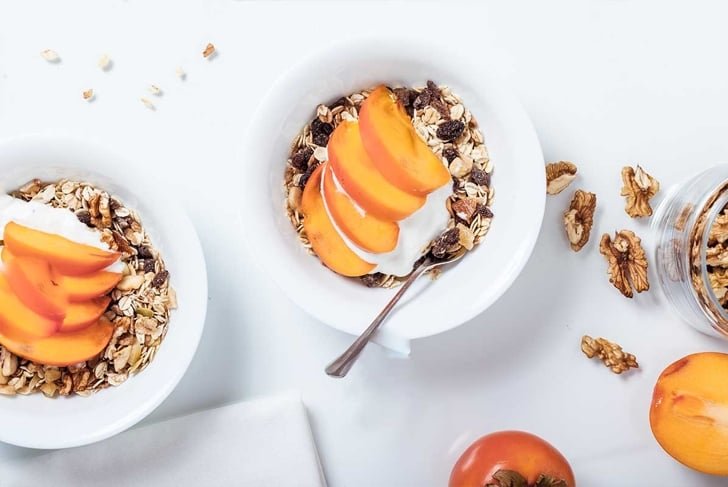Breakfast is indeed the most vital meal of the day, with evidence indicating that your morning choices can greatly affect your energy levels and mood throughout the day. If you find yourself feeling hungry or drained a few hours post-breakfast, you may be falling into these frequent breakfast traps.
01
You don’t get enough fiber
Fiber is crucial for digestive health and can help regulate blood sugar levels and cholesterol. Even with a nutrient-rich diet, you may still be falling short of the daily recommended intake, which is at least 25 to 38 grams for most adults. A fiber-rich breakfast will keep you satisfied longer and slow down carbohydrate absorption, preventing rapid spikes and drops in blood sugar. Be sure to include high-fiber options like whole grains, chia and flax seeds, nuts, and a variety of fruits and vegetables throughout your day. For instance, this Chia Seed Pudding offers 6 grams of fiber per serving!
02
You only eat traditional breakfast foods
Common breakfast items that are often low in protein and high in sugar—like instant oatmeal, cereal, and pancakes—can lead to sustained sugar cravings and fatigue. If eggs, smoothies, or Greek yogurt aren’t your favorite, consider enjoying dinner items for breakfast. Create a grain bowl using leftover lean proteins, whole grains, and vegetables for a quick, satisfying meal.
03
Your meal timing is not ideal
The timing of your meals can be more significant than you think. Syncing your meals with your body’s natural rhythms can enhance blood sugar control, reduce inflammation, and support gut health. Breakfast serves as a reset for your circadian clock, which manages sleep, hormone release, and metabolism. To reap the potential health benefits of timed eating, you might want to try methods like the 16:8 intermittent fasting approach, where you consume all meals within an 8-hour window during the day. An example could be starting your eating at 9 a.m. and wrapping up by around 4:30 p.m.
Not so fast
Everyone has unique dietary needs. Consult a dietitian or healthcare provider before starting intermittent fasting.
04
You overlook protein
Including protein in your breakfast can help maintain stable blood sugar levels, especially when combined with healthy fats. Most adults should aim for at least 0.8 to 1 gram of protein per kilogram of body weight daily, and for muscle growth, this increases to 1 to 1.6 grams per kilogram. The body can only utilize around 20 grams of protein at one time for muscle building, so spread your intake across three meals.
05
You skip breakfast
By skipping a nutrient-rich breakfast, you may fall short on essential vitamins and minerals. Research indicates that those who eat breakfast tend to have healthier diets and better blood sugar management. If morning hunger is lacking, consider reducing evening snack times or lengthening your overnight fast to a range of 12 to 16 hours.
06
You forget to plan ahead
Having a breakfast plan tailored to your lifestyle can greatly reduce the chances of making common breakfast errors. Prepare meals in advance for those hectic mornings by washing and chopping fruits and vegetables, making batches of egg muffins, preparing overnight oats, or boiling eggs for the week.
07
You make a smoothie entirely from fruit
While fresh fruit provides valuable fiber, nutrients, and antioxidants, an all-fruit smoothie may lack adequate protein and fiber. Because several fruits are often used in one smoothie, you might end up with a higher sugar content than if you had just eaten a piece of whole fruit. Enhance your smoothie by mixing low-sugar fruits like berries with protein powder or Greek yogurt. For added nutritional benefits, throw in veggies like frozen cauliflower for a creamy texture.
08
You focus solely on calorie counting
What you consume holds as much importance as the quantity. A hundred calories of sugar affect your body differently than 100 calories from healthy fats or proteins. The Institute of Medicine suggests that daily caloric intake should consist of around 45 to 65 percent carbohydrates, 10 to 35 percent proteins, and 20 to 35 percent fats. Strive for a balanced macro distribution in your meals for optimal nutrition.
09
You choose the wrong breakfast bar
Before grabbing a breakfast bar, carefully check the nutrition label. Some bars are highly processed, full of sugar, and resemble desserts more than health foods, even if they are from popular brands. Other bars might not provide enough calories or nutrients to substitute a full meal. Look for bars that have high protein, at least 3 grams of fiber per serving, minimal to no added sugars, and no hydrogenated oils.
10
You wait until lunch to incorporate color
According to the World Health Organization, adults should aim for at least five servings of fruit and non-starchy vegetables daily. Don’t wait until lunch to include these in your meals; start with breakfast instead. Add some berries and nuts to plain yogurt, include vegetables in a healthy smoothie (and remember to add protein), or whip up a vegetable omelet.





